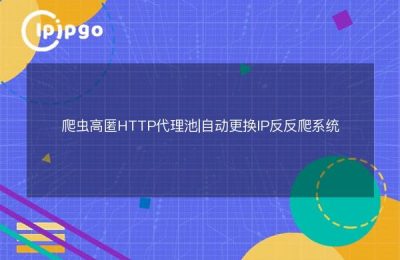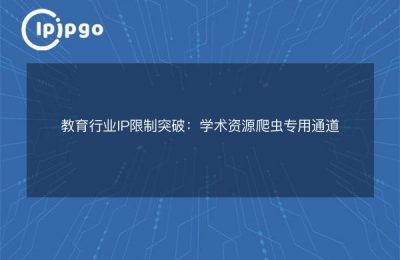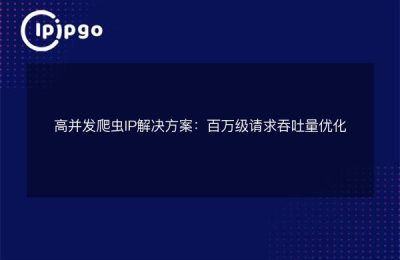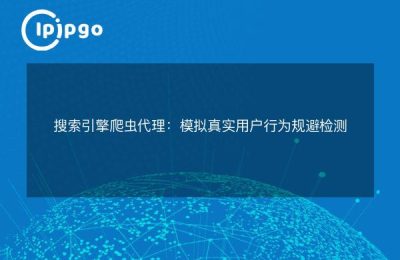
When a travel platform crawled competitors' pricing data last year, it triggered 213 anti-crawl intercepts in a single day - not that the technology wasn't strong enough, but it neglected toIP Behavioral Profiling. Modern anti-climbing systems will record: the frequency of requests from the same IP, the pattern of access times, and the combination of device fingerprints, and when these features form a model of the machine's behavior, it is only a matter of time before it is blocked.
The case of a ticketing platform served by ipipgo proxy pool: equipped with 3,000 dynamic residential IPs for the crawler system, after adopting the intelligent rotation strategy, the success rate of data collection was increased from 37% to 92%, and the average daily collected data volume exceeded 8 million items.
Three Principles of High Concurrency Crawler Agent Pool Design
Principle 1: Real network environment simulation
| anti-climbing detection point | Response program | The ipipgo implementation |
|---|---|---|
| IP type identification | Use of residential IPs instead of server room IPs | Pool of 90 million+ home broadband resources |
| Operator Characteristics | Hybridization of the three major carriers' IP | Supports filtering by ASN number |
| Geographic Reasonableness | Matching IP properties with target websites | Precise positioning in 240+ countries and regions |
Principle 2: Intelligent Traffic Distribution
- High-frequency acquisition tasks: ≤5 requests per IP per minute
- Sensitive data collection: randomization of request intervals (3-15 seconds)
- Burst traffic scenarios: automatic expansion of spare IP pools (ipipgo supports second-level IP provisioning)
Principle III: Link-wide exception handling
import ipipgo
from retry import retry
@retry(tries=3, delay=2)
def fetch_data(url): proxy = ipipgo.
proxy = ipipgo.get_proxy(
concurrency=50, # max concurrency
timeout=8, # response timeout threshold
retry_failed=True # Automatically retrying failed IPs
)
response = requests.get(url, proxies=proxy)
if response.status_code == 200.
return response.text
else.
ipipgo.report_bad_ip(proxy['ip']) # Abnormal IP auto-recovery
raise Exception('Request failed')API Interface Integration Practical Solution
Step 1: Dynamic IP Pool Initialization
Get the initial IP pool (recommended concurrency x 2) via ipipgo's REST API:
GET /api/v1/pool/create?size=500&type=dynamic&location=usStep 2: Intelligent Scheduling Middleware Development
Core Functional Modules:
- IP health monitoring (response time > 3 seconds automatically rejected)
- Request frequency control (based on sliding window algorithm)
- Geographic traffic distribution (scheduling by target web server location)
Step 3: Anti-Counter-Crawl Strategy Linkage
Open the agent pool to the following systems:
- Request header randomizer
- Mouse Trace Analog Module
- Captcha Recognition Service
Four-dimensional operation and maintenance monitoring system
Dimension 1: IP Quality Kanban
| Key indicators | health threshold | Disposal program |
| success rate | ≥95% | Below 90% triggers IP pool refresh |
| Average delay | ≤1200ms | Continuous >1500ms switching area |
Dimension 2: Cost Control Strategies
- Enabling shared IP pools during off-peak hours
- Exclusive residential IP for critical task assignments
- Automatically release IPs that have been idle for more than 30 minutes
Dimension 3: Early warning mechanisms for anomalies
Set up a level 3 alarm:
Level 1 (yellow): single IP failure rate > 30%
Level 2 (Orange): overall success rate decreased by 20%
Level 3 (red): triggers explicit anti-climbing rules
Dimension 4: Log Traceability System
Record each request:
- Use of IP and attribution
- Request response time
- Reason for exception triggering
Quickly locate problematic IP segments through ipipgo's log analysis interface
Reptile Engineer QA Dictionary
Q: What size IP pool is needed for 100 requests per second?
A: It is recommended to configure Dynamic IP Pool Capacity = QPS x Average Response Time (sec). Assuming an average response of 1.2 seconds, at least 120 IPs are required. using ipipgo's intelligent scheduling API, the actual IP consumption can be reduced by 40%.
Q: What should I do if I encounter Cloudflare protection?
A: Triple Response: ① Use an untagged residential IP ② Reduce the frequency of individual IP requests ③ Work with browser fingerprinting camouflage. ipipgo's residential IPs have a higher pass rate than regular IPs by 83%.
Q: How to avoid wasting IP resources?
A: Set up a three-tier caching strategy: high-frequency IPs are resident in memory, spare IPs are stored in Redis, and idle IPs are released in a timely manner. ipipgo's API supports on-demand real-time IP acquisition.
Q: What can be done about the high latency of transnational acquisition?
A: Use localized proxy nodes: collect US websites with US West residential IPs, and Japanese websites with Tokyo home IPs. ipipgo provides 14 backbone network access points around the world.
(This paper's technical solution is based on the realization of ipipgo proxy service system, the platform provides millisecond response API interface, supports seamless switching of SOCKS5/HTTP/HTTPS protocols, and automatically updates the 20%IP pool every day to guarantee the freshness of resources.)








